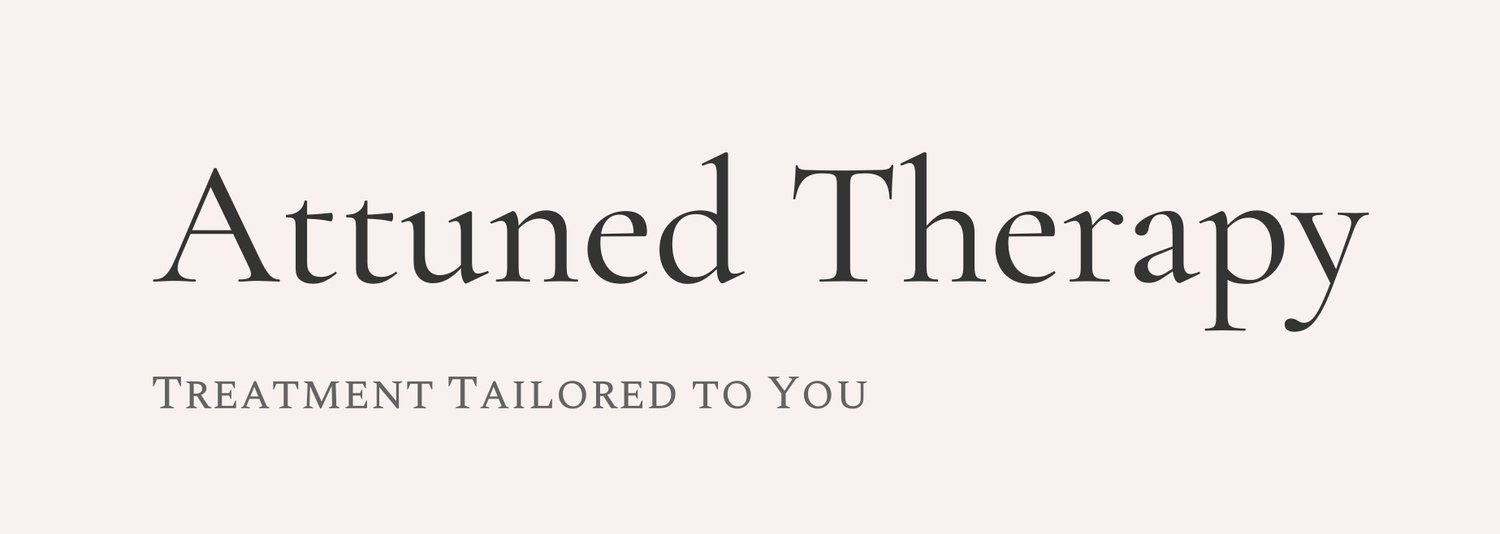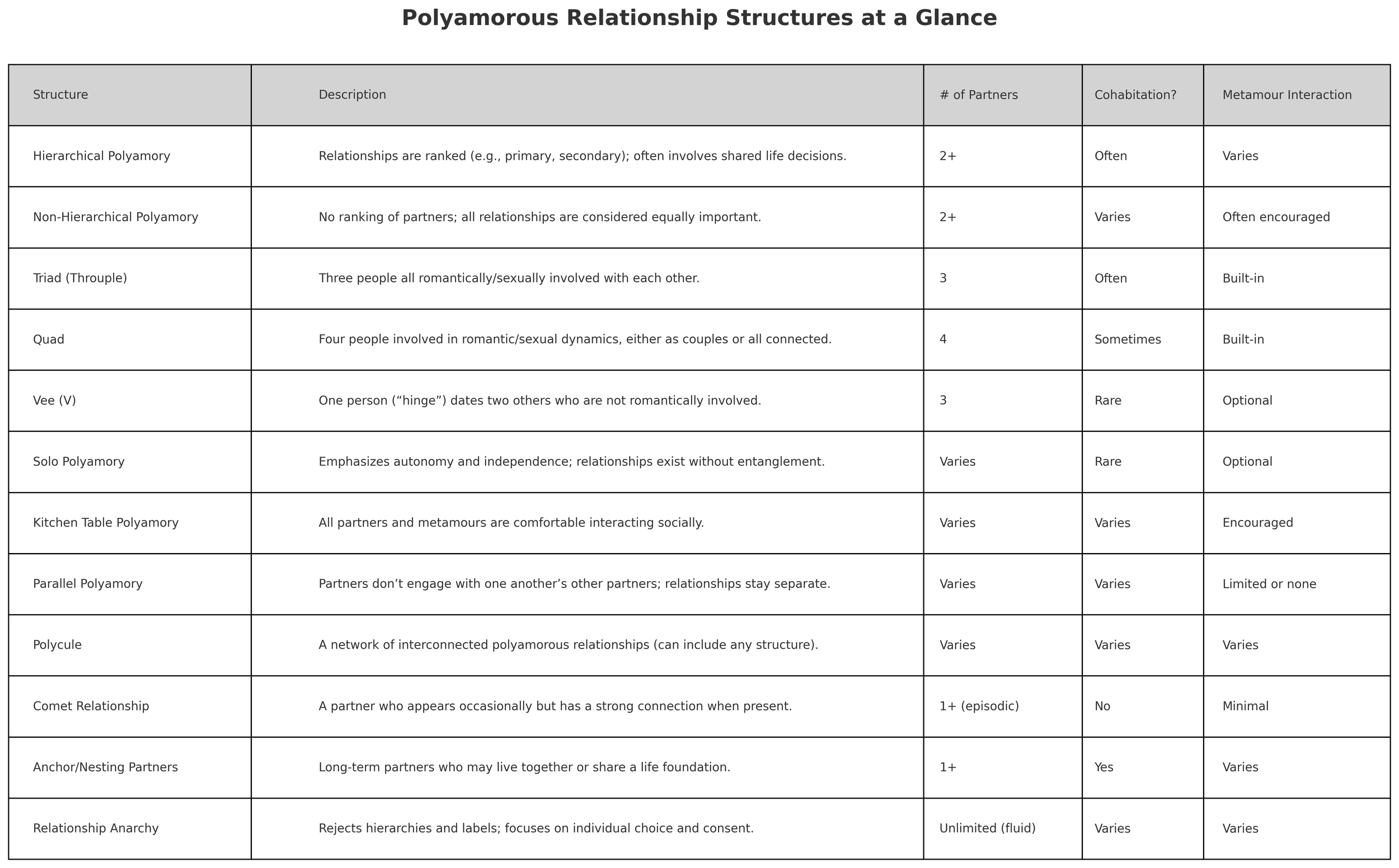12 Types of Polyamorous Relationships Explained
Love Doesn’t Have to Look Just One Way
When most people think of relationships, they picture a couple: two people, committed exclusively to each other. But for many folks—especially those who are queer, neurodivergent, or simply curious about alternatives—that picture doesn't quite fit.
Polyamory offers something different: the possibility of loving, dating, or building life with more than one person—ethically, openly, and consensually.
But here’s the thing: polyamory isn’t just one thing. There are many different types of polyamorous relationships, from deeply intertwined triads and polycules to more independent dynamics like solo polyamory or comet partners. Some people prefer structure, others crave freedom. Some build chosen families, others keep things parallel and separate.
If you're exploring what kind of poly relationship style or dynamic fits you—or you're trying to understand what your partner means when they say “non-hierarchical poly” or “kitchen table”—you’re in the right place.
This guide will walk you through 12 common polyamorous relationship structures—with real-life examples, clear definitions, and even a comparison chart to help you see how they differ. Whether you're brand new to polyamory or deep into your journey, you deserve a version of love that works for you.
What Is a Polyamorous Relationship?
Polyamory is the practice of engaging in multiple consensual, loving, and often romantic relationships at the same time. It exists under the broader umbrella of ethical non-monogamy (ENM), but with a key emphasis on emotional connection and openness.
Unlike casual open relationships, polyamory often includes deep, long-term bonds between more than two people. There’s no one “right” way to do polyamory—just what works for the people involved.
Why Understanding Poly Dynamics & Styles Matters
There are many types of polyamorous relationships, each with its own structure, emotional dynamic, and expectations. Whether you're exploring polyamory for the first time or deepening your understanding, knowing your preferences can help you:
Communicate needs clearly
Build stronger relationship agreements
Reduce misunderstandings and jealousy
Feel seen and affirmed in your identity
Ready to find out which polyamory style fits you? Let’s break it down.
12 Common Types of Polyamorous Relationships
Below, we explore the most common polyamorous types, with definitions, examples, and considerations for each.
1. Hierarchical Polyamory
Keywords: hierarchical poly, types of poly relationships
In hierarchical polyamory, relationships are ranked—usually into categories like “primary,” “secondary,” or “tertiary.” A primary relationship may involve shared finances, cohabitation, or long-term life planning, while secondary partners may have less logistical or emotional priority.
Example:
Alex and Sam are married (primary partners). Alex also dates Jordan, but major decisions are made with Sam.
Pros: Clear expectations, useful for nesting partners or families
Cons: Can lead to feelings of inequality if not navigated mindfully
2. Non-Hierarchical Polyamory
Keywords: non-hierarchical poly, different types of poly
All relationships are viewed as equally valid, regardless of living arrangements or longevity. There’s no default prioritization—each relationship is allowed to evolve on its own terms.
Example:
Taylor has two partners, Em and Noor, and considers both equally important, even though they have different dynamics.
Pros: Respects autonomy and emotional depth of each bond
Cons: Can require extensive communication to meet everyone’s needs
3. Triad (Throuple)
Keywords: poly triad relationship, triangle polyamory
A triad involves three people who are all romantically and/or sexually involved with each other. This can be closed (exclusive) or open.
Example:
Casey, Morgan, and Jules all date each other and live together as a unit.
Pros: Deep intimacy, shared energy
Cons: Jealousy or imbalance if connections aren’t equally nurtured
4. Quad
A quad involves four people in a shared network of connection. Sometimes this forms when two couples connect romantically, but it can also evolve organically.
Example:
Two couples begin dating one another, and eventually all four are romantically involved in various combinations.
Pros: Strong group energy, shared support
Cons: Complexity! Lots of feelings and schedules to manage
5. Vee (or “V”) Structure
Keywords: polyamorous v, poly dynamic
In a V, one person (called the “hinge”) is involved with two partners who are not romantically involved with each other.
Example:
Jordan is dating Avery and Nico, but Avery and Nico aren’t connected beyond friendship.
Pros: Allows one person to connect deeply with two people
Cons: The “hinge” must manage emotional balance and boundaries well
6. Solo Polyamory (Solo Poly)
Keywords: solo poly, different types of polyamory
Solo polyamorous people prioritize autonomy and independence. They may have multiple relationships but prefer not to merge households, finances, or life paths.
Example:
Mia dates two people but lives alone, makes decisions independently, and doesn’t prioritize becoming part of a couple unit.
Pros: High personal freedom
Cons: Can be misread as commitment-phobic, or misunderstood by more entangled partners
7. Kitchen Table Polyamory
Keywords: polyamory styles, types of poly relationships
In this dynamic, all partners and metamours (your partner’s partners) are comfortable interacting socially—maybe even enjoying dinner together.
Example:
Lena, Kai, and Jo all date different people but gather for birthdays and game nights as chosen family.
Pros: Community-oriented, supportive environment
Cons: Requires high emotional maturity and willingness to connect
8. Parallel Polyamory
Keywords: poly styles, poly dynamics
Here, metamours have little to no interaction. Each relationship is kept separate and respected for its own boundaries.
Example:
Morgan is dating Ellis and Jamie. Ellis and Jamie don’t know each other and prefer to keep it that way.
Pros: Low drama, clear boundaries
Cons: Can feel isolating or confusing if partners disagree on boundaries
9. Polycule
Keywords: polycule relationships, polyamory chart
A polycule is a web of connected relationships—a term used to describe the broader structure of who’s involved with whom.
Example:
Ari is part of a polycule of 6 people with overlapping romantic, platonic, and kinky connections.
Pros: Language to describe complexity
Cons: Can get emotionally or socially overwhelming
10. Comet Relationships
Keywords: comet poly, comet relationship meaning
A comet partner is someone you see occasionally, perhaps a few times a year, but when you do, the connection is intense and loving.
Example:
Reese and Drew live on opposite coasts and connect once or twice a year, but deeply love each other.
Pros: Low-maintenance, high-intensity
Cons: Can be hard for people who crave consistent connection
11. Anchor/Nesting Partnerships
These are partners you may live with, co-parent with, or otherwise share a life foundation with, even if you’re open to other relationships.
Example:
Sky and Rowan are nesting partners who live together, while both also date other people.
Pros: Stability, shared logistics
Cons: Can unintentionally slip into hierarchy without clarity
12. Relationship Anarchy
Keywords: relationship menu, understanding polyamory
Relationship Anarchy rejects default scripts. There are no assumptions about what a relationship “should” look like—labels, rules, and roles are co-created or thrown out entirely.
Example:
Juniper forms connection based on mutual trust and affinity—no expectations around labels, timelines, or exclusivity.
Pros: Maximum freedom and creativity
Cons: Can be hard for partners who crave structure
Comparison Chart: Polyamorous Structures at a Glance
Finding What Poly Relationship Structure Works for You
Reading the list of the 12 poly relationship structures can feel overwhelming. Know that you do not need to conform to any of these. There’s no perfect poly model—only the one that supports your values, needs, and boundaries. If you feel compelled to create your own designer relationship structure then try that! The key is that these terms are also just descriptors to help folks identify and acknowledge their unique poly relationship structure, but they’re not meant to be another confining box.
If you’re curious if you’d prefer any of these poly relationship types, it can be helpful to reflect upon the following.
Ask yourself:
Do I prefer shared or separate spaces?
How much time do I want to spend with metamours?
Do I want to prioritize one partner—or none?
Am I okay sharing the same partner with another partner?
Frequently Asked Questions
What’s the difference between a Vee and a Triad?
A Vee has one shared partner; a triad involves all three people dating one another.
Can you be solo poly with nesting partners?
Yes! Labels are tools, not cages.
What is a polycule?
It’s the visual/relational map of everyone connected through love, intimacy, or care in your poly network.
Do you have to pick just one style?
Nope. Many people shift over time or blend styles. Create your own designer relationship as fluid as you are!
Final Thoughts: Build Your Own Relationship Menu
There’s no single “right” way to do polyamory—just the way that aligns with your values, your needs, and your capacity for connection.
Some people thrive in tightly woven polycules. Others value the independence of solo polyamory. Many move fluidly between structures over time as relationships evolve. The beauty of polyamory is that it invites you to define what love, intimacy, and connection mean to you—without being confined by someone else’s script.
If you’re feeling overwhelmed or unsure where to begin, that’s completely okay. Polyamory isn’t about doing it all perfectly—it’s about staying in integrity with yourself and building relationships that feel good in your body, not just your head.
Whether you’re exploring for the first time, renegotiating an existing relationship, or healing from past dynamics that didn’t serve you, you deserve guidance, clarity, and support.
Ready to Explore What Works for You?
If you’re curious about your own polyamory style—or navigating the complexities of multiple relationships—it helps to talk to someone who understands the nuances.
At Attuned Therapy, I work with individuals and couples who are exploring or actively practicing ethical non-monogamy, including polyamory, relationship anarchy, and more.
Book a consultation today to explore your relationship landscape with curiosity, care, and support.





